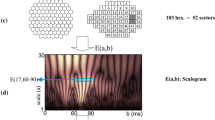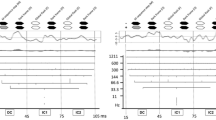Abstract
The paper discusses creating a wavelet-based feature space for the classification of transient pattern electroretinograms (PERGs)—signals utilized in ophthalmology to evaluate the state of the retina. Discrete wavelet transform (DWT) can provide compact signal description, which is more accurate than time-domain data. A procedure for the proper choice of transform parameters is proposed. Both time-domain and wavelet features of these waveforms are visualized using principal components analysis. Separability of feature spaces is compared using k-means clustering algorithm. The results suggest that PERG waveforms are better separable when represented by DWT coefficients of full time-domain signal, than in traditional peak-based feature space.







Similar content being viewed by others
References
Aldroubi A, Unser M (1996) Wavelets in medicine and biology. CRC Press, Boca Raton
Akay M (1997) Time frequency and wavelets in biomedical signal processing. Wiley-IEEE Press, New York
Duda R, Hart P, Stork D (2000) Pattern classification. Wiley-Interscience, New York
Osowski S, Nghia D (2002) Fourier and wavelet descriptors for shape recognition using neural networks—a comparative study. Pattern Recognit 35:1949–1957
Kim K, Parlos (2002) Induction motor fault diagnosis based on neuropredictors and wavelet signal processing. IEEE ASME Trans Mechatron 7:201–219
Huang J, Negnevitsky M, Nguyen D (2002) A neural-fuzzy classifier for recognition of power quality disturbances. IEEE Trans Power Deliv 17:609–616
Poppele R, Maffei L (1967) Frequency analysis of the electroretinogram. J Neurophysiol 30:982–992
Hazarika N, Chen J, Chung T, Siergiejew A (1997) Classification of EEG signals using the wavelet transform. Signal Process 59:61–72
Englehart K, Hudgins B, Parker P, Stevenson M (1999) Classification of the myoelectric signal using the wavelet transform. Med Eng Phys 21:431–438
Pittner S, Kamarthi S (1999) Feature extraction from wavelet coefficients for pattern recognition tasks. IEEE Trans Pattern Anal Mach Intell 12:83–88
Kandaswamy A, Kumar C, Satish C, Jayamaran S, Malmurgan N (2004) Neural classification of lung sounds using wavelet coefficients. Comput Biol Med 34:523–537
Bach M, Hawlina M, Holder G, Marmor H, Meigen T, Miyake Y (2000) Standard for pattern electroretinography. Doc Ophtalmol 101:11–18
Poularikas D (2000) The transforms and applications handbook. CRC Press, Boca Rotan
Misti M, Misti Y, Oppenheim G, Poggi J (2000) Wavelet toolbox. The Mathworks Inc., Natick
Acknowledgements
This paper was supported by a grant from the Polish State Committee for Scientific Research (KBN) number 3T11 023 28.
Author information
Authors and Affiliations
Corresponding author
Rights and permissions
About this article
Cite this article
Rogala, T., Brykalski, A. Wavelet feature space in computer-aided electroretinogram evaluation. Pattern Anal Applic 8, 238–246 (2005). https://doi.org/10.1007/s10044-005-0003-9
Received:
Accepted:
Published:
Issue Date:
DOI: https://doi.org/10.1007/s10044-005-0003-9




